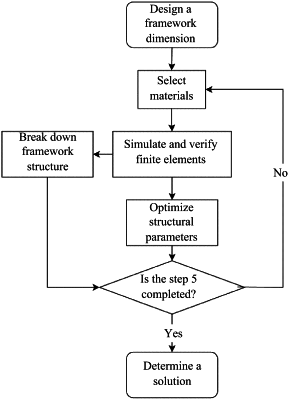| CPC G06F 30/10 (2020.01) [G01M 7/02 (2013.01); G06F 30/23 (2020.01)] | 6 Claims |

|
1. A design method for a support structure of a large-scale vibrational excitation platform, comprising the following steps:
step 1. designing a framework dimension: preliminarily determining a dimension of a support framework according to a dimension of the vibrational excitation platform, and sketching out a preliminary model of the support structure;
step 2. selecting materials: considering application requirements, processing time and other factors, and selecting and optimizing materials for the framework in combination with subsequent simulation results;
step 3. breaking down framework structure: breaking down the framework into a plurality of components based on a model of the support structure, and determining connection methods among all components;
step 4. simulating and verifying finite elements: analyzing a local mode and deformation due to force of motor backup plates, as well as an overall mode of the entire framework according to usage conditions, and obtaining simulation results;
step 5. optimizing structural parameters: verifying whether the support framework designed above meets the usage requirements based on the results obtained in the step 4; optimizing structures and dimensions of weak parts when the verification reveals that the support framework fails to meet the same; going back to the step 2 when it is necessary to change the materials, and then moving on to the step 4 to perform simulation and verification of finite elements; and directly go to the step 2 when the materials are qualified, until the simulation results meet the usage requirements; and
step 6. determining a solution: when the step 4 is successfully completed, determining a final support framework structure in combination with the results of the step 3, and sorting out models of all parts and simulation files to form a final solution.
|